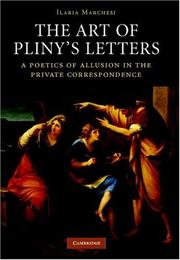| Listing 1 - 10 of 12 | << page >> |
Sort by
|
Book
ISBN: 0813211514 9780813211510 0813200512 9780813200514 9780813200514 Year: 1964 Publisher: Washington, D.C. Catholic University of America Press
Abstract | Keywords | Export | Availability | Bookmark
 Loading...
Loading...Choose an application
- Reference Manager
- EndNote
- RefWorks (Direct export to RefWorks)
The letters, of which eighty-one have come down to us, written from c.249 until his death in 258 A.D., may be found translated in this volume.
Cyprian, --- Caecilius Cyprianus, --- Cebrià, --- Cipriano, --- Cyprian, von Karthago, --- Cyprianus, --- Cyprianus, Thascius Caecilius, --- Cyprien, --- Tascio Cecilio Cipriano, --- Thascius Caecilius Cyprianus, --- Pseudo-Cyprian,
Book
ISBN: 2731406178 2821853181 Year: 2008 Publisher: Presses universitaires d’Aix-Marseille
Abstract | Keywords | Export | Availability | Bookmark
 Loading...
Loading...Choose an application
- Reference Manager
- EndNote
- RefWorks (Direct export to RefWorks)
Languages & Literatures --- Greek & Latin Languages & Literatures --- Pliny, --- Rome --- Politics and government. --- History --- Gaius Plinius Secundus Minor --- C. Plini Caecili Secundi --- Pline le Jeune --- Plinius de jongere --- Plinius der Jüngere --- Caius Plinius, --- Gaĭ T︠S︡et︠s︡iliĭ Pliniĭ Sekund, --- Gaj Plinije, --- Kaĭ Pliniĭ T︠S︡et︠s︡iliĭ Vtoroĭ --- Pline, --- Pliniĭ, --- Plinio, --- Plinius Caecilius Secundus, C. --- Plinius Caecilius Secundus, Caius --- Plinius, Caius, --- Plinius Caecilius Secundus, Gaius --- biographie --- correspondance (littérature) --- gouvernement --- droit antique
Book
ISBN: 9783110208740 3110208741 9786612716737 1282716735 3110217260 9783110217261 Year: 2009 Volume: 269 Publisher: Berlin ; New York Walter de Gruyter
Abstract | Keywords | Export | Availability | Bookmark
 Loading...
Loading...Choose an application
- Reference Manager
- EndNote
- RefWorks (Direct export to RefWorks)
Die Untersuchung bemüht sich, die im allgemeinen vernachlässigte künstlerische Form der Briefe des jüngeren Plinius herauszustellen. Behandelt werden folgende Themen: Exempla antiquitatis (Würdigungen großer Männer, die noch die alte Zeit verkörpern und für Plinius vorbildhaft sind: Verginius Rufus, Titius Aristo, Antoninus Arrianus, Cornutus Tertullus), Verfall der individuellen Freiheit nicht nur unter Domitian, sondern auch unter Trajan, des Senats und der Redekunst der Gegenwart, bedeutende Schriftsteller in Vergangenheit und Gegenwart (Cicero, Plinius der Ältere, Silius Italicus, Martial), humanitas im Umgang mit anderen (sowohl mit anderen Völkern als auch mit Frauen und Sklaven), schließlich die Villa als geistiger Lebensraum und die Rezeption der Landschaft. Plinius spricht jeweils aus einem dezidiert eigenen Blickwinkel heraus. Auf diese Weise ergibt sich ein Gesamtbild seiner geistigen Persönlichkeit sowie der kulturellen Bedingungen der Epoche, da das Einverständnis der Adressaten aus dem Senatorenstand vorauszusetzen ist.
Pliny, --- Plinius Caecilius Secundus, Gaius --- Aesthetics. --- Authors, Latin --- Correspondence --- History and criticism. --- Caius Plinius, --- Gaĭ T︠S︡et︠s︡iliĭ Pliniĭ Sekund, --- Gaj Plinije, --- Kaĭ Pliniĭ T︠S︡et︠s︡iliĭ Vtoroĭ --- Pline, --- Pliniĭ, --- Plinio, --- Plinius Caecilius Secundus, C. --- Plinius Caecilius Secundus, Caius --- Plinius, Caius, --- Gaius Plinius Secundus Minor --- C. Plini Caecili Secundi --- Pline le Jeune --- Plinius de jongere --- Plinius der Jüngere --- Ancient History. --- Classical Archaeology. --- Classical Philology. --- Pliny the Younger.
Book
ISBN: 8884537983 8884537975 9788884537980 Year: 2008 Publisher: Firenze : Firenze University Press,
Abstract | Keywords | Export | Availability | Bookmark
 Loading...
Loading...Choose an application
- Reference Manager
- EndNote
- RefWorks (Direct export to RefWorks)
Esistenza minima brings together the results of a study carried out by the author in connection with his degree thesis. A celebrated pre-text – the letter of Pliny the Younger to Gallus in which he describes the Laurentian villa – becomes the mesh into which he weaves the pivotal figures of modernity. The continual cross-referencing of word and drawing, word and image, builds into a procedural approach that clearly posits the design dimension as the cognitive foundation. It is a singular, somewhat unusual text that transports the reader into a territory where the common ground between narration and memoir, the work of the masters and the personal diary, is intriguingly explored.
Architecture --- Philosophy. --- Pliny, --- Homes and haunts. --- Laurentine Villa (Laurentum) --- Gaius Plinius Secundus Minor --- C. Plini Caecili Secundi --- Pline le Jeune --- Plinius de jongere --- Plinius der Jüngere --- Caius Plinius, --- Gaĭ T︠S︡et︠s︡iliĭ Pliniĭ Sekund, --- Gaj Plinije, --- Kaĭ Pliniĭ T︠S︡et︠s︡iliĭ Vtoroĭ --- Pline, --- Pliniĭ, --- Plinio, --- Plinius Caecilius Secundus, C. --- Plinius Caecilius Secundus, Caius --- Plinius, Caius, --- Plinius Caecilius Secundus, Gaius --- Architettura --- Progettazione architettonica --- Disegno architettonico --- Plinio il giovane --- Franco Realla --- Adolfo Natalini
Book
ISBN: 9780521603799 0521842921 9780521842921 9781139024747 052160379X 1139334042 1107225647 1139337416 9786613571786 1139339869 1139341448 1139338285 1139024744 1139336541 1280393866 9781139338288 9781139336543 9781139339865 9781107225640 9781139334044 9781280393860 6613571784 9781139337410 9781139341448 Year: 2015 Publisher: Cambridge: Cambridge University Press,
Abstract | Keywords | Export | Availability | Bookmark
 Loading...
Loading...Choose an application
- Reference Manager
- EndNote
- RefWorks (Direct export to RefWorks)
This is the first general introduction to Pliny's Letters published in any language, combining close readings with broader context and adopting a fresh and innovative approach to reading the letters as an artistically structured collection. Chapter 1 traces Pliny's autobiographical narrative throughout the Letters; Chapter 2 undertakes detailed study of Book 6 as an artistic entity; while Chapter 3 sets Pliny's letters within a Roman epistolographical tradition dominated by Cicero and Seneca. Chapters 4 to 7 study thematic letter cycles within the collection, including those on Pliny's famous country villas and his relationships with Pliny the Elder and Tacitus. The final chapter focuses on the 'grand design' which unifies and structures the collection. Four detailed appendices give invaluable historical and scholarly context, including a helpful timeline for Pliny's life and career, detailed bibliographical help on over 30 popular topics in Pliny's letters and a summary of the main characters mentioned in the Letters.
Brevskrivning --- Letter writing, latin --- Letter writing, latin. --- Ancient, classical & medieval. --- Plinius, --- Plinius Caecilius Secundus, Gaius, --- Correspondence (Pliny, the Younger). --- Literary collections --- Historia. --- History --- Pliny, --- Criticism and interpretation. --- Criticism, Textual. --- Antiken. --- To 1500. --- Arts and Humanities --- Letter writing, Latin --- Plinius Caecilius Secundus, Gaius --- Gaius Plinius Secundus Minor --- C. Plini Caecili Secundi --- Pline le Jeune --- Plinius de jongere --- Plinius der Jüngere --- Caius Plinius, --- Gaĭ T︠S︡et︠s︡iliĭ Pliniĭ Sekund, --- Gaj Plinije, --- Kaĭ Pliniĭ T︠S︡et︠s︡iliĭ Vtoroĭ --- Pline, --- Pliniĭ, --- Plinio, --- Plinius Caecilius Secundus, C. --- Plinius Caecilius Secundus, Caius --- Plinius, Caius,

ISBN: 9780521882279 0521882273 9780511482298 9780521296977 0511387288 9780511388279 0511388276 9780511387289 0511482299 0521296978 1281254967 9786611254964 0511386257 0511384424 0511382618 Year: 2008 Publisher: Cambridge [etc.] Cambridge University Press
Abstract | Keywords | Export | Availability | Bookmark
 Loading...
Loading...Choose an application
- Reference Manager
- EndNote
- RefWorks (Direct export to RefWorks)
In this book on intertextuality in Pliny the Younger, Professor Marchesi invites an alternative reading of Pliny's collection of private epistles: the letters are examined as the product of an authorial strategy controlling both the rhetorical fabric of individual units and their arrangement in the collection. By inserting recognisable fragments of canonical authors into his epistles, Pliny imports into the still fluid practice of letter-writing the principles of composition and organisation that for his contemporaries characterised other writings as literature. Allusions become the occasion for a metapoetic dialogue, especially with the collection's privileged addressee, Tacitus. An active participant in the cultural politics of his time, Pliny entrusts to the letters his views on poetry, oratory and historiography. In defining a model of epistolography alternative to Cicero's and complementing those of Horace, Ovid and Seneca, he also successfully carves a niche for his work in the Roman literary canon.
Allusions in literature. --- Allusions dans la littérature --- Pliny, --- Criticism and interpretation. --- Correspondence --- Criticism, Textual. --- Allusions dans la littérature --- Allusions in literature --- Caius Plinius, --- Gaĭ T︠S︡et︠s︡iliĭ Pliniĭ Sekund, --- Gaj Plinije, --- Kaĭ Pliniĭ T︠S︡et︠s︡iliĭ Vtoroĭ --- Pline, --- Pliniĭ, --- Plinio, --- Plinius Caecilius Secundus, C. --- Plinius Caecilius Secundus, Caius --- Plinius, Caius, --- Gaius Plinius Secundus Minor --- C. Plini Caecili Secundi --- Pline le Jeune --- Plinius de jongere --- Plinius der Jüngere --- Plinius Caecilius Secundus, Gaius --- Arts and Humanities --- History --- Pline le Jeune (0061?-0114?) --- Lettres --- Allusion (rhétorique) --- Intertextualité --- Critique et interprétation
Multi
ISBN: 9783110414721 9783110417401 9783110417487 3110414724 3110417413 3110417480 3110417405 Year: 2015 Volume: 340 Publisher: Berlin ; Boston De Gruyter
Abstract | Keywords | Export | Availability | Bookmark
 Loading...
Loading...Choose an application
- Reference Manager
- EndNote
- RefWorks (Direct export to RefWorks)
Das vorliegende Buch bietet erstmals eine systematische Studie zu den Literaturzitaten in den Briefen des jüngeren Plinius. Im Zentrum steht die Betrachtung aller Zitate aus den ,Klassikern' Homer und Vergil, die Plinius bevorzugt zitiert. Ein allgemeiner Teil stellt die Fallstudien in den Kontext der Kulturtechnik des Zitierens und befasst sich mit formalen und inhaltlichen Aspekten der Zitation bei Plinius als Gesamtphänomen. Die 16 thematisch angeordneten Briefe mit Zitaten aus Homer und Vergil sowie einigen anderen Autoren werden ausgehend von der Zitationstechnik, der Funktionalisierung der Zitate und ihren Implikationen eingehend analysiert. Über ihr intertextuelles Potential bereichern die Zitate die Briefe um vielfältige Bezugsebenen, unterstützen die Darstellung und fungieren als Strukturelement. Sie tragen wesentlich zu Plinius' Selbstporträt als römischer Aristokrat, Privatmann und Literat bei und spiegeln seine Ciceronachfolge. Als gezielt eingesetztes Kommunikationsmittel zwischen Autor und Publikum werfen sie schließlich ein Licht auf die zeitgenössische Bildungs- und Standeskultur an der Wende zum 2. Jh. n. Chr. und sind ihm Rahmen des literarischen Klassizismus jener Zeit verankert.
Citations grecques --- Citations latines --- Histoire et critique --- Pline le Jeune, --- Citations --- Pliny, --- Criticism and interpretation. --- Caius Plinius, --- Gaĭ T︠S︡et︠s︡iliĭ Pliniĭ Sekund, --- Gaj Plinije, --- Kaĭ Pliniĭ T︠S︡et︠s︡iliĭ Vtoroĭ --- Pline, --- Pliniĭ, --- Plinio, --- Plinius Caecilius Secundus, C. --- Plinius Caecilius Secundus, Caius --- Plinius, Caius, --- Histoire et critique. --- Gaius Plinius Secundus Minor --- C. Plini Caecili Secundi --- Pline le Jeune --- Plinius de jongere --- Plinius der Jüngere --- Homer. --- Literaturzitate. --- Pliniusbriefe. --- The Letters of Pliny. --- Vergil. --- Virgil. --- literary citations. --- Zitat --- Literatur --- LITERARY CRITICISM / Ancient & Classical. --- Belletristik --- Dichtung --- Schöne Literatur --- Sprachkunst --- Wortkunst --- Buch --- Schriftsteller --- Geflügeltes Wort --- Zitieren --- Zitierung --- Zitierweise --- Zitierpraxis --- Zitate --- Plinius Caecilius Secundus, Gaius --- Schöne Literatur --- Geflügeltes Wort

ISBN: 3598730012 3111843874 3110958287 9783110958287 9783598730016 Year: 2000 Publisher: München: Saur,
Abstract | Keywords | Export | Availability | Bookmark
 Loading...
Loading...Choose an application
- Reference Manager
- EndNote
- RefWorks (Direct export to RefWorks)
No detailed description available for "Onomasticon to the Younger Pliny".
Names, Personal --- Names, Latin --- -Latin language --- Latin names --- Anthroponomy --- Baby names --- Christian names --- Family names --- Forenames --- Names of families --- Names of persons --- Personal names --- Surnames --- Names --- Pliny the Younger --- Pliny, the Younger --- -Correspondence --- Noms de personnes --- Noms latins --- Indexes --- Indexes. --- Index --- Caius Plinius, --- Gaĭ T︠S︡et︠s︡iliĭ Pliniĭ Sekund, --- Gaj Plinije, --- Kaĭ Pliniĭ T︠S︡et︠s︡iliĭ Vtoroĭ --- Pline, --- Pliniĭ, --- Plinio, --- Plinius Caecilius Secundus, C. --- Plinius Caecilius Secundus, Caius --- Plinius, Caius, --- Latin language --- Onomastics --- Pliny, --- Correspondence --- Gaius Plinius Secundus Minor --- C. Plini Caecili Secundi --- Pline le Jeune --- Plinius de jongere --- Plinius der Jüngere --- Plinius Caecilius Secundus, Gaius --- Names, Personal - Rome - Indexes. --- Names, Latin - Indexes.
Book
ISBN: 1139088904 1107222079 1283127563 1139092723 9786613127563 113909324X 1139092219 1139090402 113909131X 0511920571 9781139093248 9781139092210 9781107009059 1107009057 9781139088909 9781107222076 9781283127561 9781139092722 6613127566 9781139090407 9780511920578 9781107526501 1107526507 Year: 2011 Publisher: Cambridge ; New York : Cambridge University Press,
Abstract | Keywords | Export | Availability | Bookmark
 Loading...
Loading...Choose an application
- Reference Manager
- EndNote
- RefWorks (Direct export to RefWorks)
"Pliny's Panegyricus (AD 100) survives as a unique example of senatorial rhetoric from the early Roman Empire. It offers an eyewitness account of the last years of Domitian's principate, the reign of Nerva and Trajan's early years, and it communicates a detailed senatorial view on the behaviour expected of an emperor. It is an important document in the development of the ideals of imperial leadership, but it also contributes greatly to our understanding of imperial political culture more generally. This volume, the first ever devoted to the Panegyricus, contains expert studies of its key historical and rhetorical contexts, as well as important critical approaches to the published version of the speech and its influence in antiquity. It offers scholars of Roman history, literature and rhetoric an up-to-date overview of key approaches to the speech, and students and interested readers an authoritative introduction to this vital and under-appreciated speech"--
Speeches, addresses, etc., Latin --- Praise in literature. --- History and criticism. --- Pliny, --- Gaius Plinius Secundus Minor --- C. Plini Caecili Secundi --- Pline le Jeune --- Plinius de jongere --- Plinius der Jüngere --- Caius Plinius, --- Gaĭ T︠S︡et︠s︡iliĭ Pliniĭ Sekund, --- Gaj Plinije, --- Kaĭ Pliniĭ T︠S︡et︠s︡iliĭ Vtoroĭ --- Pline, --- Pliniĭ, --- Plinio, --- Plinius Caecilius Secundus, C. --- Plinius Caecilius Secundus, Caius --- Plinius, Caius, --- Literary style. --- Rome --- Rim --- Roman Empire --- Roman Republic (510-30 B.C.) --- Romi (Empire) --- Byzantine Empire --- Rome (Italy) --- Politics and government --- Historiography. --- Plinius Caecilius Secundus, Gaius --- Praise in literature --- History and criticism --- Arts and Humanities --- History

ISBN: 3110182475 3110919842 3111796981 Year: 2004 Volume: 4 Publisher: Berlin ; New York Walter de Gruyter
Abstract | Keywords | Export | Availability | Bookmark
 Loading...
Loading...Choose an application
- Reference Manager
- EndNote
- RefWorks (Direct export to RefWorks)
Welche Bedeutung kam dem biographischen Wissenssegment im Kontext der Bildungskultur des 2. Jh. n. Chr. zu? Welche Formen wurden von zeitgenössischen Autoren zur literarischen Präsentation von Personen gewählt? Unter dieser doppelten Leitfrage werden hier Personendarstellungen in den Briefen des jüngeren Plinius, dem Miszellanwerk des Gellius und den Kaiserbiographien Suetons in einer gattungsübergreifend angelegten Perspektive untersucht. Zu den Gemeinsamkeiten, die sich auf diese Weise beobachten lassen, gehören das normative Potential historischer Figuren, die Kommemoration von Zeitgenossen und die Interaktion mit den kommunikativen Rahmenbedingungen der römischen Kaiserzeit. Eine solche funktionsgeschichtliche Betrachtungsweise zeigt ferner, dass es sich bei vielen der Charakteristika der untersuchten Autoren, die bislang als Abweichungen von der jeweiligen Gattungstradition kritisiert wurden, um bewusste Entwicklungen handelt, die eng auf ihren gemeinsamen gesellschaftlichen und kulturellen Kontext bezogen sind. What role did biographies play for the intelligentsia of the 2nd century AD? What literary forms were used by contemporary authors in their personal portrayals? These two questions have led to this cross-genre investigation of the personal portraits in the letters of Pliny the Younger, in the miscellaneous work of Gellius, and in the Lives of the Caesars by Suetonius. Among the common features which can thus be observed are the normative potential of historical figures, the commemoration of contemporaries, and the interaction with communicative conditions of the Roman Empire. Such a functional and historical perspective further demonstrates that many of the characteristics of the featured authors, which to date have been seen as deviations from the genre tradition, are, in actuality, conscious developments, closely related to the authors' common social and cultural background.
Pliny, --- Suetonius, --- Gellius, Aulus. --- Aulu-Gelle --- Gelio, Aulo --- Gelius, Aulius --- K. Svetoniĭ Trankvill, --- Sueton, --- Suétone, --- Suetone Tranquile, --- Suetonius Tranquillus, C. --- Suetonius Tranquillus, C., --- Suetonius Tranquillus, Gaius, --- Sveton, --- Svetonio, --- Svetonio Tranquillo, Gaio, --- Tranquillus, Gaius Suetonius, --- Светоний, --- סוטוניוס --- Caius Plinius, --- Gaĭ T︠S︡et︠s︡iliĭ Pliniĭ Sekund, --- Gaj Plinije, --- Kaĭ Pliniĭ T︠S︡et︠s︡iliĭ Vtoroĭ --- Pline, --- Pliniĭ, --- Plinio, --- Plinius Caecilius Secundus, C. --- Plinius Caecilius Secundus, Caius --- Plinius, Caius, --- Rome --- Rim --- Roman Empire --- Roman Republic (510-30 B.C.) --- Romi (Empire) --- Byzantine Empire --- Rome (Italy) --- Biography --- History and criticism. --- Civilization. --- Gelli, Auli --- Avl Gelliĭ --- Gelliĭ, Avl --- Gellius, A. --- Gelle, Aulu --- Gellio, Aulo --- Gelyus, Olus --- Gelyus, Ulus --- גליוס, אולוס --- Gelius, Aulus --- Gaius Plinius Secundus Minor --- C. Plini Caecili Secundi --- Pline le Jeune --- Plinius de jongere --- Plinius der Jüngere --- Plinius Caecilius Secundus, Gaius --- Bildungsideal. --- Kulturelle Kommunikation. --- Oberschicht. --- Römische Kaiserzeit. --- Römisches Reich. --- HISTORY / Ancient / General. --- Suetonius Tranquillus, Caius --- Suétone --- Suetonio --- Suetonius --- Pliny the Younger --- Gellius --- Lives of the Caesars --- Suetoniu --- 2nd century AD --- intelligentsia --- biographies
| Listing 1 - 10 of 12 | << page >> |
Sort by
|

 Search
Search Feedback
Feedback About UniCat
About UniCat  Help
Help News
News